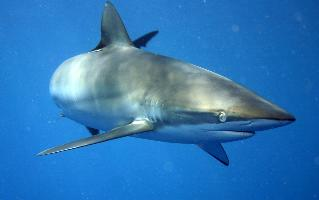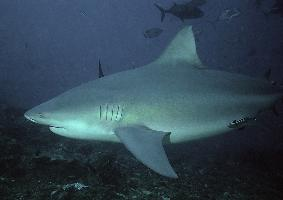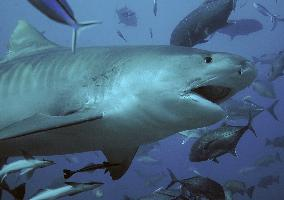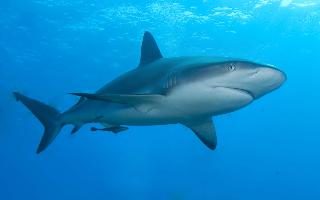
Popis zvířete
The Caribbean reef shark (Carcharhinus perezi) is a captivating species of requiem shark, belonging to the family Carcharhinidae. Renowned for its sleek and powerful build, this shark is a predominant figure in the warm, crystal-clear waters of the Caribbean Sea, from the Bahamas and Florida to Brazil, though it is found most densely within the central Caribbean islands. An embodiment of the ocean's mystery and grace, the Caribbean reef shark plays a vital role in the marine ecosystem, maintaining the delicate balance of the reef's community.Typically, the Caribbean reef shark measures between 2 to 2.5 meters (6.5 to 8.2 feet) in length, although some individuals can grow up to 3 meters (10 feet). They possess a robust, streamlined body, with a broad, rounded snout and large, oval eyes that provide excellent vision in the murky reef waters. Their coloration is a beautiful, subtle blend of gray and brown hues on the dorsal side, transitioning to a white or pale underbelly, allowing them to camouflage effectively within the reef environment.
One of the most distinguishing features of the Caribbean reef shark is its dorsal fins. The first dorsal fin is large and triangular, situated closer to the pectoral fins than the pelvic fins, which is a characteristic trait among requiem sharks. The second dorsal fin is relatively small, a feature that aids in swift navigation through the complex reef structures. Additionally, they possess a long upper tail that contributes to their agility and speed, enabling them to catch prey or evade threats within the confines of the coral reefs.
The diet of the Caribbean reef shark is as diverse as the ecosystem it inhabits. They primarily feed on a variety of bony fishes, cephalopods, and crustaceans. Their role as apex predators helps control the populations of these species, thus preventing any single species from dominating and altering the ecological balance of the reef habitat.
Caribbean reef sharks exhibit fascinating social and reproductive behaviors. They are often seen in groups, especially when resting during the day in specific areas of the reef known as "cleaning stations" where small fish species remove parasites from their skin. This symbiotic relationship highlights the interconnectedness of reef ecosystems. Reproduction is viviparous, with females giving birth to live young after a gestation period of about one year. Litters can range from 4 to 6 pups, which are born in shallow nursery areas that provide ample protection from predators.
Despite their formidable appearance and predatory nature, Caribbean reef sharks are generally indifferent to humans. They are a popular attraction for divers seeking the thrill of shark encounters, contributing significantly to eco-tourism in the Caribbean region. However, like many shark species, they face threats from human activities, including habitat destruction, pollution, and overfishing, both as bycatch and for the shark fin trade.
Conservation efforts are underway to protect the Caribbean reef shark and its habitat. Marine protected areas, shark sanctuaries, and regulations on shark fishing are some of the measures being implemented to ensure the survival of this magnificent species. Through research, education, and sustainable tourism practices, we can appreciate the beauty and ecological importance of the Caribbean reef shark while safeguarding its future in the world's oceans.
Mapa výskytu
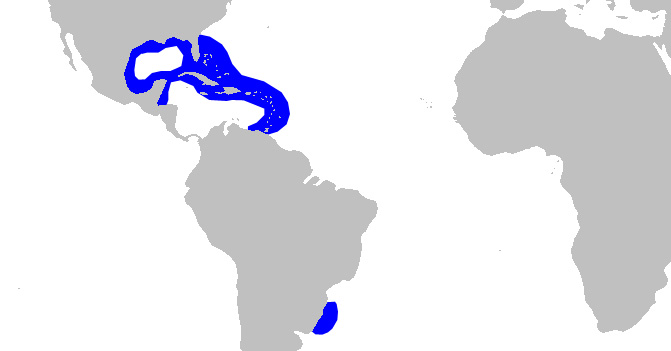
Podobná zvířata
Nové fotografie zvířat
Top 10 zvířat
- Chinese water dragon (Physignathus cocincinus)
- Galápagos tortoise (Geochelone nigra complex)
- Dolphin gull (Leucophaeus scoresbii)
- Japanese macaque (Macaca fuscata)
- Colombian red howler (Alouatta seniculus)
- Sea urchins (Echinoidea)
- Diana monkey (Cercopithecus diana)
- Moustached guenon (Cercopithecus cephus)
- Colossal squid (Mesonychoteuthis hamiltoni)
- Common house mosquito (Culex pipiens)
